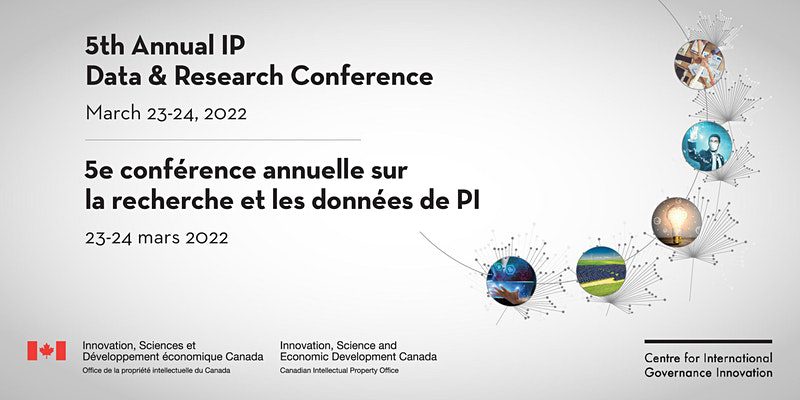
 Sally Yoon is an IPilogue Writer and a 2L JD Candidate at Osgoode Hall Law School.
Sally Yoon is an IPilogue Writer and a 2L JD Candidate at Osgoode Hall Law School.
This article is part of a series covering the 5th Annual IP Data & Research Conference, hosted by the Canadian Intellectual Property Office and the Centre for International Governance Innovation.
The 5th Annual IP Data & Research Conference, organized by the Canadian Intellectual Property Office (“CIPO”) and the Centre for International Governance Innovation (“CIGI”), included a session on “Clean Technologies” about the status of Canada’s IP ownership and cleantech sector. The moderators were Joel Blit (professor of economics at the University of Waterloo and senior fellow at CIGI) and Rich Corken (deputy director of economics, research and evidence at UKIPO).
Trends and Challenges in Canada’s IP Ownership and a Collective’s Role in Addressing these Challenges
Mike Mclean (chief executive officer of the Innovation Asset Collective (“IAC”)), Emma Start (director of intellectual property at Taiga Motors), and Dan Herman (founder of Go To Jupiter Productions and special advisor on the Establishment of a Centralized Resource Entity on the Intellectual Property) spoke about Canadian small-to-midsize enterprises’ (“SMEs”) role as significant economic drivers. They outlined some of the key challenges SMEs face in participating successfully in the IP ecosystem:
- Cost and complexity: The cost of acquiring patents and the complexity of the international system deters companies from participating.
- Lack of focus in IP education on strategy-linked business outcomes and commercial success: There are challenges in applying theoretical IP knowledge to real-life practical situations, which shows a need to provide SMEs with more “granular, case-study-based” education.
- Limited talent capacity available: There is a limited talent capacity available to help businesses with their IP strategies and limited connectivity to institutions and existing expert players.
- Limited tools for support: Companies require more support to bridge the gap from starting an IP program to having a self-sufficient IP system and operation. This is also critical for international commercialization.
The IAC is taking a collective approach to tackle these challenges. Their initiatives include building a collective patent portfolio and obtaining IP insurance at cost-effective rates for members, conducting market and patent research to inform strategy development, and providing businesses with IP software tools. Moreover, Intellectual Property Ontario, a board-governed agency set to begin operations later this year, will also work towards addressing the above four issues to help clients access the market.
Clean Technologies’ Economic Impact and Innovation
Nicholas Johnston (junior policy analyst in the Strategy and Innovation Policy Sector at Innovation, Science and Economic Development Canada) and Mazahir Bhagat (data scientist in Business Improvement Services at CIPO) shared statistics on the Canadian cleantech sector and its activity in IP.
Overall, statistics showed that the cleantech sector is steadily growing and well-funded, with nearly all financing requests made by SMEs being approved in 2017. The sector was also active in IP—cleantech firms were most likely to participate in strategic activities related to IP, and enterprises in the sector showed more overall familiarity with IP than the average enterprise. Patent filing trends related to CO2 conversion and hydrogen production showed that Canadian inventions constituted about 1-2 percent, with the U.S., China, and Japan being the leaders. Businesses formed a significant chunk of the institutions filing the patents in Canada and globally, with interestingly high participation from the academic sector.
Patent Analytics on Hydrogen and Low Emission Technologies
Catriona Bruce (head of Patent Analytics Hub at IP Australia) looked at the patent filing of low emissions technology and hydrogen. Global patent data from PATSTAT showed that solar photovoltaic cells had the leading number of global patents filed, with most hydrogen patent filings being direct to production and utilization. China was the leading source of invention for both solar photovoltaic cells and inverter and hydrogen patents, as well as a leading target market. Interestingly, patents filed in China mostly stayed within the country; 17264 filings out of about 30000 hydrogen filings were from China, with only 809 from outside of the country. Relatively fewer inventions came from Canada and Australia, indicating further initiative for investment in domestic capability.
IP in Climate Transformative Technology Companies: The SDTC Approach
Amber Batool (vice president and chief of staff at Sustainable Development Technology Canada (“SDTC”)) spoke about how SDTC enforces business leadership through mentorship. Its education programs frame advice for companies and address the issue that very few Canadian companies have the mature IP to compete or financial ability to keep up. Select companies with effective IP strategies have been mentors in education programs to frame advice for companies. SDTC’s approach to making an impact includes thought leadership, tailored IP strategies and learning pathways, and IP capacity creation. It plans to continue collaborating with others doing valuable work in this area to meet its clients’ changing IP needs.
Canada has the lowest labour productivity of the G7 and is the only G7 country whose R&D has gone down over the last 20 years. The panel discussions provided valuable insights into Canada’s current position within the cleantech sector and the next steps necessary to achieve our national objectives for the environment and economy while maintaining a globally prominent position within the IP ecosystem.

